Plan On Lifting or Squatting Something Heavy? Check Your Neck
Today’s guest post comes courtesy of frequent contributor, Dr. Nicholas Licameli. He covers a topic that’s sometimes controversial:
Neck position when lifting heavy things.
Some people play close attention to it (as they should), while others play it off as “no big deal” and point towards really strong people who seemingly have never had any issues with their neck(s).
“See! They do it.”
Yeah, well, you’re not them. And most other people aren’t either.1
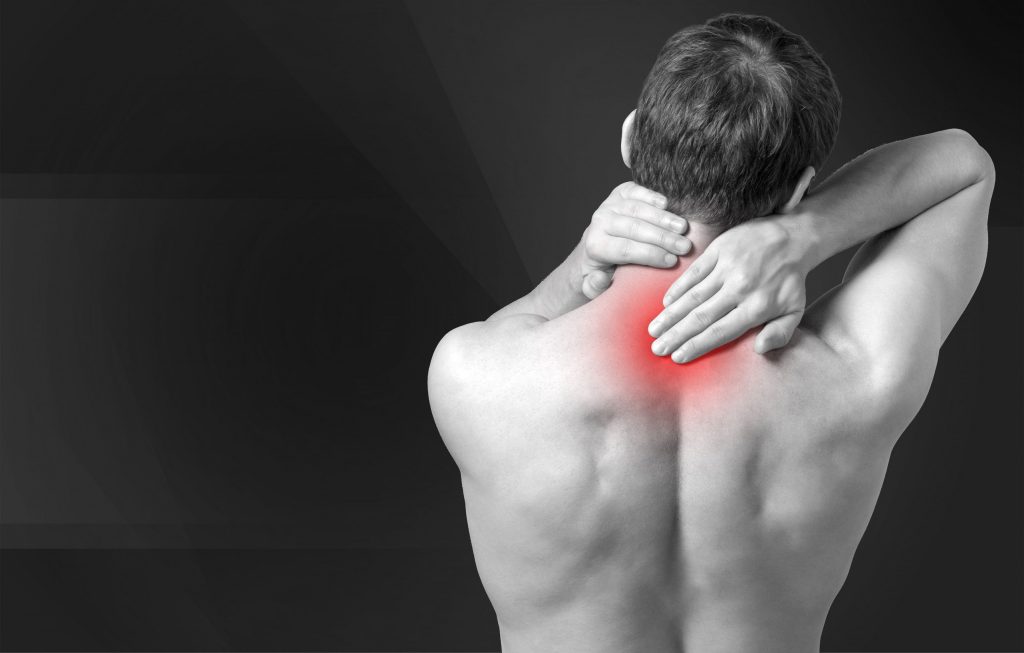
Copyright: olegdudko / 123RF Stock Photo
Plan On Lifting or Squatting Something Heavy? Check Your Neck
One of the most common issues I see in the deadlift and squat (and plank, push-up, bent over row, etc.) even in experienced lifters, is forgetting to “set” the head and neck.
- Feet gripping floor with 3 points of contact? Check.
- Pelvic floor engaged? Check. Transverse abdominis braced? Check. Diaphragm engaged? Check.
- Shoulders and scapulae tucked down and back, squeezing the armpits? Check.
- Neck straight and chin tucked?…
The hip hinge is the foundation to all movements that involve bending over or squatting. A proper hip hinge starts at the hips (naturally) with your spine in a neutral position.
But “spine in neutral position” does not just refer to the lower back. It includes the often-neglected cervical spine, too.
Too often I see the head and neck extended in an otherwise perfect hip hinge (see image below). I lie awake at night wondering why we lose so many good men out there (playing for the Yankees?2) to poor mechanics and why this mistake is so common…here’s what I came up with.
The extended position of the cervical spine can be very dangerous.
It is akin to having a hard arch in the lower back (the facet joints and neural tissues become compressed) except that the joints, muscles, nerves, and other structures of the neck are smaller and more delicate.
Add the maximal contraction of pretty much every muscle, as seen when performing a deadlift or squat, and it is clear to see why this can be dangerous.
So why do so many of us assume this faulty position?
Part of the reason is because our heads always want to be looking upright. Our brains subconsciously want to position our heads so that we are looking at the horizon.
We all know that the end goal is to stand up straight. We feel as if “looking where we’re going,” will help us get there. In order to maintain proper cervical positioning, we have to fight our subconscious, which is never easy.
[Another reason could be that we want to catch ourselves in that perfect lighting for that perfect selfie…]
But I think a big reason why extending the head and neck is so common is because it creates a shortened lever arm, which improves the biomechanical efficiency of the lift.
Let me explain.
When you bend forward in a proper hip hinge, the hip becomes a fulcrum. As a result, a lever is formed from the hip to the top of the head. The longer the lever arm, the harder the load is to move.
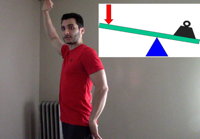
Think of the difference between picking up a dumbbell out to the side of your body (as in a lateral raise) versus tucked into your side (as in a shrug).
When lifting out to the side, the shoulder joint is the fulcrum, the lever arm is the arm, and the load is in the hand at the end of the lever.
Lifting with your arm straight out to the side produces a longer lever arm than lifting close to the body, which makes the load more difficult to lift. This is the same reason why many coaches cue lifters to keep the load as close to your shins as possible during a deadlift. The further the load is from the fulcrum (your hip), the harder it is to lift.
What does it all mean Basil?3
It means that extending the head and neck during a deadlift may be the body’s subconscious attempt to improve the biomechanical efficiency of the lift. It essentially shortens the lever arm by about a “head’s length.” (see images below).
![]()
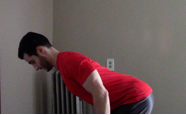

Shortened lever arm by about a “head’s length
To ensure proper positioning, tuck the chin and align the neck with the rest of your spine before lifting the load (see image below).
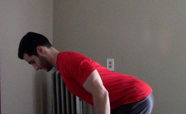
So next time you deadlift, yes, make sure your hip hinge is on point (and you get that perfect lighting for that selfie), but don’t forget about your vitally important and often neglected head and neck.
Resist the urge to look up!
Your discs, joints, muscles, and nerves will thank you.
Video Explanation
About the Author
Every single thing he does, Nick believes in giving himself to others in an attempt to make 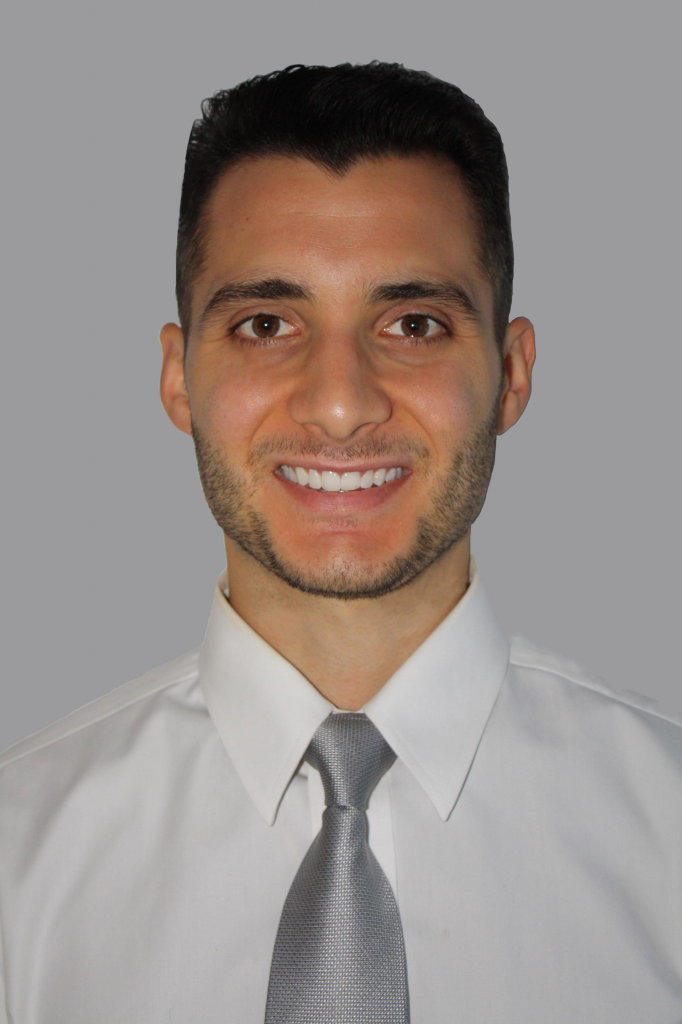 the world a happier, healthier, and more loving place. He wants to give people the power to change their lives. Bodybuilding and physical therapy serve as ways to carry out that cause. His knowledge of sport and exercise biomechanics, movement quality, and the practical application of research combined with personal experience in bodybuilding and nutrition allows him to help people in truly unique ways. Love. Passion. Respect. Humility. Never an expert. Always a student. Love your journey.
the world a happier, healthier, and more loving place. He wants to give people the power to change their lives. Bodybuilding and physical therapy serve as ways to carry out that cause. His knowledge of sport and exercise biomechanics, movement quality, and the practical application of research combined with personal experience in bodybuilding and nutrition allows him to help people in truly unique ways. Love. Passion. Respect. Humility. Never an expert. Always a student. Love your journey.

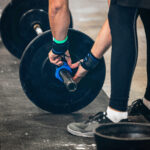

Comments for This Entry
PLAN ON LIFTING OR SQUATTING SOMETHING HEAVY? CHECK YOUR NECK – My WordPress Website
[…] Source: http://tonygentilcore.com/2017/11/plan-lifting-squatting-something-heavy-check-neck/ […]November 9, 2017 at 12:56 pm |
kerve
Some pull their head up to compensate for poor positioning (forward lean). Looking up helps keep from falling forward.November 10, 2017 at 1:09 pm |
QUESTION FOR COACH 5 (BRET CONTRERAS) – Micro Training
[…] LUKA KOVACEVIC: Guys, the next time you think looking up in a deadlift isn’t a big deal read the great article HERE. […]November 12, 2017 at 1:31 pm |
Luka Kovacevic
Great article, by the way Bret Contreras says that looking up in a deadlift is not a big deal?!November 14, 2017 at 10:23 pm |
Tony Author
For strong lifters and those with experience....I'd agree. For beginners, not so much.November 15, 2017 at 11:52 am |
Nicholas Licameli
Thanks! Glad you enjoyed it. I agree with Bret, but as with many topics in exercise science, I think the answer lies in a gray area. It always depends on the individual. Just like Tony mentions above, some people have to "earn the right to deviate from 'good' technique." Hard extension of the cervical spine (just like in the lumbar spine) is probably never a good thing, but will a slight deviation from neutral in an experienced lifter cause the spine to break into a million pieces? Probably not : )November 25, 2017 at 3:21 pm |
QUESTION FOR COACH 6 (Dr Nicholas Licameli) – Micro Training
[…] Link to article […]December 13, 2017 at 9:31 pm |
Carlos Eduardo Rogacheski
Nice article. May i should do this when i paddle on my surf board. The problem is that you have to look forward (extending neck and head) to know where you are going to or if some waves are coming! The pain in my neck has limited my surf active after more than 2 hours surfing or when i surf a entire swell (2-4 days continuous).February 22, 2018 at 7:37 am |
Nicholas Licameli
Hey Carlos! I definitely see how that could be problematic and hard to work around. I am not a surfing expert by any means, but I would say try to take frequent breaks from the constant extension by maybe performing some chin tucks and neck flexion throughout your time on the board. These can be done while lying on your stomach, lying on your back, or sitting upright on the board. Either way, be sure to get in some quality neck strengthening and postural stabilization work while off the board. A qualified physical therapist will be able to point you in the right direction in person. Key word there is qualified! If someone tells you to stop surfing completely, get a new PT!June 23, 2018 at 1:40 pm |